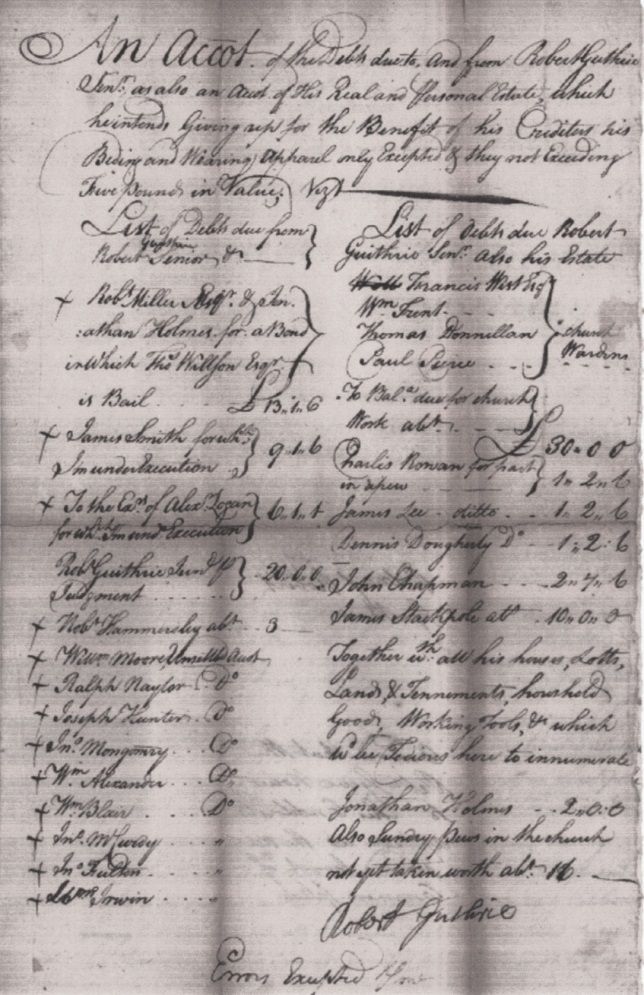An “honest laborious man” by his own account; a fighting Irishman judging from the number of times he was indicted for assault and battery,1 Guthrie built many houses in Carlisle during the 25 or more years he worked, including the “English” Church (St. John’s Episcopal Church).2
According to a family genealogy, Guthrie married Bridget Dougherty in Ireland in 1736. They came to America in 1744; first to Philadelphia and then to Lancaster, Pennsylvania in 1747.3 Guthrie is listed on a document titled “Lot Applyers” for Carlisle May, 1751,4 making him one of the original residents of the town.
Guthrie owned two adjoining lots on the south side of East Pomfret Street #290 and #298. Guthrie’s neighbor on the west, from 1760-1762, was Charles Boyle and his family. Boyle, a wagoner, purchased his lot on May 8, 1760, and within the first month of living there the trouble with Guthrie began. In a deposition dated May 29, 1760, Boyle’s wife Catharine claimed she was assaulted by Guthrie. She said that he came into her house when she was ironing clothes and knocked down Mary Coleman and tried to knock her down. She said she had to “fly for her life and is now afraid to return to her dwelling on account of Guthrie.”
Guthrie was indicted for assault and battery on Catharine Boyle again in March 1762, and her husband, likely coming to her defense, hit Guthrie and was indicted for assault himself. Two months later Boyle sold his property and left Carlisle.
In January, 1770, Guthrie, “a languishing prisoner for debts in the Goal of said county,” petitioned the court for the Act of Insolvency.5
“The humble petition of Robert Guthrie, Sr. most humbly showeth to your worships that I, your petitioner, being under execution, has been confined this six months during which time your petitioner has suffered great hardships in several respects, especially for want of my health, and your petitioner being indebted several sums of money and by reason of several losses and misfortunes and especially not being paid for the work of the English Church, (St. John’s Episcopal Church) your petitioner is unable to pay his creditors…Your petitioner begs leave to acquaint your worships that I have been one of the first settlers in this town, and has dealt in large sums of money with most of the dealers in this town and none of them can say but that I am an honest laborious man. Therefore your petitioner humbly begs that I may not be looked on as if I was intending to defraud any of my creditors, for if your petitioner was to get value for all his real and personal estate, it would amount to three times as much as what your petitioner is indebted…Your petitioner humbly prays that your worships will consider his distressed condition as also your petitioner has an old, tender, helpless wife not being able to provide for herself.”
Guthrie’s insolvency petition also stated that James Alcorn was indebted to him for £15 “on account of building his brick a house.” Also, Guthrie went bail for Dennis Sweeney for a debt Sweeney owed to James Stackpole, and because of that Guthrie’s house and lot was sold while he was in prison. Among Guthrie’s list of possessions were Lots #290 and #298, a 10-acre out lot with four acres of fall crop almost fenced, bedding, carpenter tools, a few walnut boards, “a few chairs sum finished and sum not,” a “wheel car" [sic] and a small parcel of house furniture.
Guthrie also owned Lot #266 on the south side of East Pomfret Street which later became the site of the Roman Catholic Church. In 1770, when Guthrie declared insolvency, his lot was sold by the sheriff to Carlisle mason James Stackpole.6 Stackpole also purchased Guthrie’s Lot #298 at a sheriff sale.7 There was no love lost between the men, and now they were neighbors. In 1772, Guthrie and his wife Bridget threatened to assault Stackpole who they said had entered their lot and pulled down and broke part of a picket fence.
The 1771 tax list of Carlisle records Robert Guthrie as “poor” with one lot. He does not appear on Carlisle tax lists after that year, and nothing more is known about him.

![Robert Guthrey’s [sic] tavern account for 1765-1769 with John Fulton who kept the Sign of the Indian Queen in Carlisle before moving to York, PA to keep a tavern. York Heritage Trust , York, Pennsylvania. Robert Guthrey’s [sic] tavern account for 1765-1769 with John Fulton who kept the Sign of the Indian Queen in Carlisle before moving to York, PA to keep a tavern. York Heritage Trust, York, Pennsylvania.](https://gardnerlibrary.org/sites/default/files/entry/Guthrie2_0.jpg)